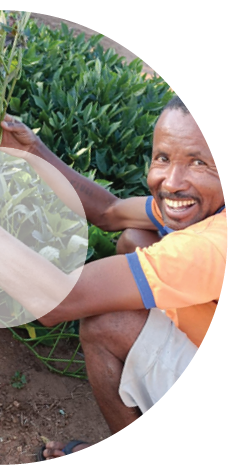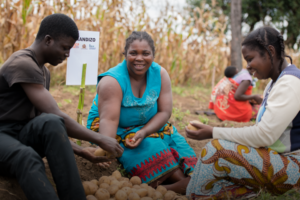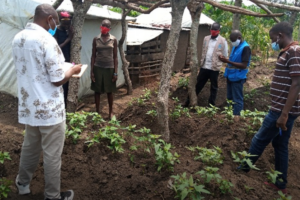From white to orange – targeting malnutrition where it counts
Sweetpotato is the third most important food crop in Southern Madagascar after rice and cassava. It is grown and eaten by the majority of vulnerable households and is gaining in popularity thanks to its resilience to climate change – a severe drought in 2021 doubled the number of people requiring emergency food aid as many households lost or consumed their crops.
“As the climate becomes even more erratic, sweetpotato’s resilience becomes more important,” said Jan Low, Principal Scientist, CIP. “It is a vital source of food and nutrition in a country where 42% of children have Vitamin A deficiency. Supporting communities in Southern Madagascar to add three biofortified orange-fleshed varieties to their sweetpotato production system dominated by white-fleshed varieties brings an excellent source of Vitamin A into the diet and provides food faster as these varieties mature earlier than the dominant local ones.”
The project aims to empower communities to produce and consume orange-fleshed sweetpotato – over 80,000 households have been targeted and reached in three regions of Madagascar.
“Sweet Recovery is providing farmer access to quality adapted planting materials and the tools they need to cultivate them and to store and prepare roots for consumption and future planting seasons,” said Miora Rakotoarimanana, Food Security and Resilience Specialist, USAID. “It enables vulnerable families to move toward food and nutrition security and away from reliance on emergency aid, even at times of crop failure.”
Putting vine production into the hands of farmers
Before the project, fewer than 5% of farmers cultivated orange-fleshed sweetpotato in Madagascar, so one of the starting points was to start building a decentralized seed system to empower local communities to produce their own vines. This has resulted in 58 vine multipliers (individuals and groups of farmers) who are trained Quality Declared Seed Producers. The objective is to ensure that each variety is not mixed with another, they are vigorous, and free of pests and diseases. Vine multipliers have distributed more than 330,948 kg of five different improved varieties to over 82,737 households*, achieving their target. In addition, the three drought-tolerant varieties deployed come from the national breeding program (FIFAMANOR) which, with the support of CIP, has selected and released 12 orange-fleshed sweetpotato varieties since 2009.
“Having vine multipliers integrated into the community builds awareness of the varieties and increases farmer access to and knowledge about them which in turn helps them reduce the risks of losses from the uncertain weather patterns we are now seeing here,” said Benjamin Rakotoarisoa, Senior Project Manager, CIP. “We need to remember that when farmers switch from cultivating varieties, they are familiar with to lesser known ones, they need to be confident that they are doing so to bolster the food and income security of their families, not risking it. This is why tracking the uptake is so important to the success of this project.”
On the right digital track
The latest digital tools are used to track the production and consumption of the orange-fleshed sweetpotato varieties – Irene, Bôra, and Donga. Household data captured includes if the household has planted or not and why, plot size, the status of the crop, a photo, and if they are using planting techniques learned during the training. Each household and each vine multiplier are registered into the system and subsequently tracked, with household selection prioritized by those at most risk of Vitamin A deficiency, for example, households with young children or pregnant women. Data are updated weekly in the centralized location.
“The digital tools have been a game-changer as researchers can see if the varieties and approaches are being adopted almost in real-time, and to track inspection data on seed quality for the vine multipliers,” said Mickael Randriamamonjy, Monitoring and Evaluation Officer, CIP.
Pairing Community Agents for Data Collection
Collecting data can be a challenge. Beneficiaries and farms not always close to each other and there may be limited access to good roads, a power supply, and the internet. To overcome this, the project has created and trained a network of 174 Community Agent Pairings (CAPs) consisting of a male and female member of the local population working together to collect data and do training.
“The CAPS are often young people who have some level of education, for example, they may have attended at least secondary school,” said Fanilo Andrianisaina, Data Manager, CIP, Madagascar. “We give them tablets to register beneficiaries and train them on how to use it, which can require even the most basic instruction such as how to power up the system as many have not used one before. This approach effectively puts data collection at the heart of the community which builds trust and skills.”
The last word
While digital technology is helping to transform results tracking, when it comes to spreading the word about the benefits of OFSP for resilience and nutrition, sometimes the more traditional routes work best.
“Low levels of literacy and challenges of communication in local dialects mean we have to think about audience needs,” said Domoina Ratsirahonana, Nutritionist, CIP. “The CAPs can help break through some of these barriers as they are part of local communities. We have also introduced visuals such as cooking demonstrations and recipe cards, and even written a song in the Androy dialect to help us spread the word.”
Donors and partners
Ampela Mitraoke Association
DRAE – Direction Regionale de l’Agriculture et CIRAE: Circoscription de l’Agriculture et de l’Elevage
FIFAMANOR
FIHAMY
ONN-Office National de Nutrition,
USAID
*As of 31 May 2023







